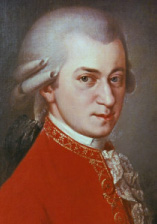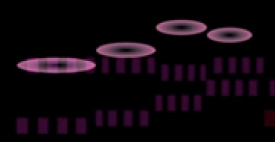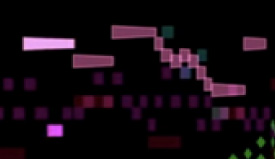|
|
Wolfgang Amadeus Mozart
|
|
This year’s Music Memory contest features the 4th movement of Mozart’s Symphony No. 41, often called the “Jupiter Symphony.” The 4th movement is entitled “Molto Allegro,” Italian words that mean “very fast”, “quick” or “bright.”MUSIC MEMORY SELECTION:
Watch and listen to the 4th movement of the Jupiter Symphony played here by the English Chamber Orchestra under the direction of Jeffrey Tate.
When you think that the average “pop” tune lasts anywhere from 3-5 minutes, it’s quite amazing that composers like Mozart were able to write symphonies that lasted ten times as long. The entire Jupiter Symphony, comprised of 4 movements, lasts nearly 45 minutes. The 4th movement itself is approximately 9 minutes long.
“Repetition” is one of the devices used by composers to expand their works. In the 4th movement of the Jupiter Symphony, Mozart builds the structure of the 4th movement on multiple themes or “motifs,” repeating them in various ways to develop and extend the duration of the movement. Stephen Malinowski has created a video that will help you understand thematic repetition in the 4th movement. Even if you do not yet read music, watching visual images of the themes as they appear and reappear during the movement will permit you to actually see and hear the repetitions embedded in the movement. We’ll watch for two of the main themes as we listen. Here’s what they will look like in Stephen Malinowski’s video:
Theme "A" Theme "B" Listen closely as you watch the video. Each time you see one of the above image-shapes appear in the 4th movement, either in whole or in part, you are hearing the musical theme represented by the image-shape. The Hoboken Symphony under the direction of Gary Schneider, accompanies the video.
Listen and watch again, but this time, try counting how many times Theme A is played in whole or in part. Now count the number of times you hear the orchestra play Theme B, again in whole or in part.
KEYWORDS: pianoforte / nuances / voices / musical ornaments / dynamics / tempo / harpsichord / clavichord / thematic repetition / motif THINGS TO THINK ABOUT: The style of music during Bach's period (Baroque) was quite different than the style during Mozart’s period (Classical). The musical instruments Bach had available to him, were different than those available to Mozart. For example, Bach composed music for the harpsichord and clavichord; Mozart composed music for the pianoforte. Because instruments were different, the sounds of their music were also different. Mozart’s music is more nuanced because instruments in his day were capable of producing greater variation in dynamics (loud and soft). Bach’s music has many more voices arranged contrapuntally, so its texture is much heavier because of the number of voices sounding simultaneously. The texture of Mozart’s music is often lighter. Rather than stacking multiple voices contrapuntally, Mozart would give the melody to one instrument and use the remaining instruments to accompany the melodic line. Tempo was very rigid during the Baroque period when Bach was composing. During Mozart’s time, composers enjoyed more flexibility. Listen to the following two excerpts. The first is a piece composed by Bach, the second, a piece composed by Mozart. As you listen, think about the voices: do they intertwine, all sounding at the same time, or do many of the voices seem to “accompany” a single, main voice? As you listen, try to imagine images that you think would go along with each of the pieces. Baroque Period Bach: Brandenburg Concerto No. 3, performed by Apollo’s Fire, Cleveland’s Baroque Orchestra, directed by Jeannette Sorrell:
Classical Period
Mozart: Piano Concerto No. 23 – 1st Movement – Allegro, performed by Valdimir Horowitz. Carlo Maria Giulini conducts the Orchestra of La Scala, Milan:
|
|





